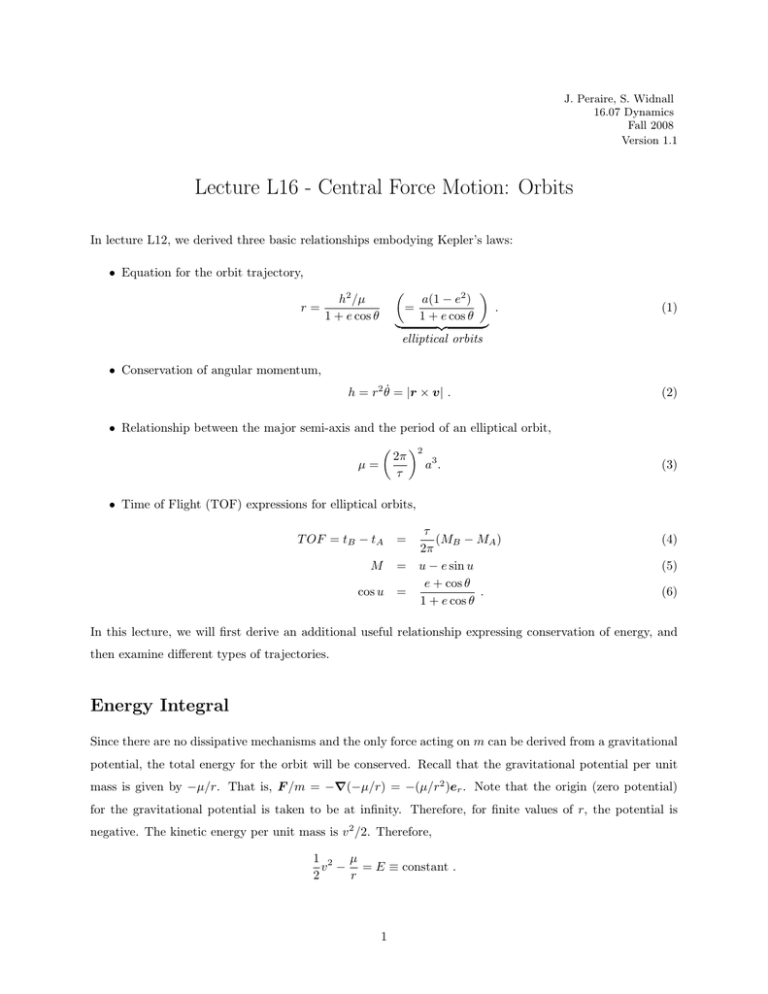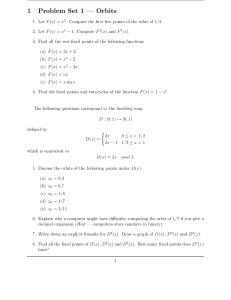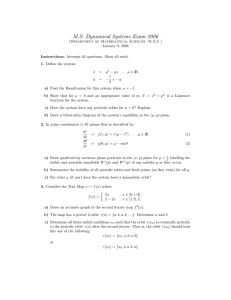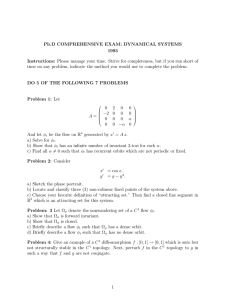Lecture L16 - Central Force Motion: Orbits
advertisement

J. Peraire, S. Widnall 16.07 Dynamics Fall 2008 Version 1.1 Lecture L16 - Central Force Motion: Orbits In lecture L12, we derived three basic relationships embodying Kepler’s laws: • Equation for the orbit trajectory, h2 /µ r= 1 + e cos θ � a(1 − e2 ) = . 1 + e cos θ � �� � elliptical orbits � (1) • Conservation of angular momentum, h = r2 θ̇ = |r × v| . (2) • Relationship between the major semi-axis and the period of an elliptical orbit, � µ= 2π τ �2 a3 . (3) • Time of Flight (TOF) expressions for elliptical orbits, τ (MB − MA ) 2π M = u − e sin u e + cos θ cos u = . 1 + e cos θ T OF = tB − tA = (4) (5) (6) In this lecture, we will first derive an additional useful relationship expressing conservation of energy, and then examine different types of trajectories. Energy Integral Since there are no dissipative mechanisms and the only force acting on m can be derived from a gravitational potential, the total energy for the orbit will be conserved. Recall that the gravitational potential per unit mass is given by −µ/r. That is, F /m = −�(−µ/r) = −(µ/r2 )er . Note that the origin (zero potential) for the gravitational potential is taken to be at infinity. Therefore, for finite values of r, the potential is negative. The kinetic energy per unit mass is v 2 /2. Therefore, 1 2 µ v − = E ≡ constant . 2 r 1 The total specific energy, E, can be related to the parameters defining the trajectory by evaluating the total energy at the orbit’s periapsis (θ = 0). From equation 1, rπ = (h2 /µ)/(1 + e), and, from equation 2, vπ2 = h2 /rπ2 = µ(1 + e)/rπ , since rπ and vπ are orthogonal at the periapsis. Thus, E= 1 2 µ µ2 vπ − = 2 (e2 − 1). 2 2h rπ (7) We see that the value of the eccentricity determines the sign of E. In particular, for e<1 the trajectory is closed (ellipse), and E < 0, e=1 the trajectory is open (parabola), and E = 0, e>1 the trajectory is open (hyperbola), and E > 0. Equations 1, 2, and 3, together with the energy integral 7, provide most of relationships necessary to solve basic engineering problems in orbital mechanics. Types of Orbits Elliptic Orbits (e < 1) When the trajectory is elliptical, h2 = aµ(1 − e2 ) (see lecture L12). Then, the total specific energy simplifies to E = −µ/(2a), and the conservation of energy can be expressed as 1 2 µ µ v − =− . 2 r 2a (8) This expression shows that the energy (and the period) of an elliptical orbit depends only on the major semi-axis. We also see that for a fixed a, the value of h determines the eccentricity. There are two limiting cases: e → 1, which gives h → 0, which in turn implies that the minor semi-axis of the ellipse b → 0; and √ e = 0 which corresponds to a circular orbit with h = aµ. In the first case, the maximum value of the eccentricity is limited by the size of the planet, since, for sufficiently large values of e, the trajectory will collapse onto the planet’s surface. Below we show three elliptical trajectories that have the same energy (same value of a), but different eccentricities. 2 Circular Orbits (e = 0) This is a particular case of an elliptic orbit. The energy equation is given by equation 8. The radius is constant h2 v2 r2 = c . µ µ For orbits around the earth, µ = gR2 , where g is the acceleration of gravity at the earth’s surface, and R is r= the radius of the earth. Then, µ gR2 = , (9) r r which shows that the velocity of a circular orbit is inversely proportional to the radius. We now consider vc2 = two particular orbits of interest: 1) r = R This corresponds to a hypothetical satellite orbiting the earth at a zero altitude above the earth’s surface. The orbit’s velocity is vc = � gR = 7910 m/s, and the period, from equation 3, is 2π τ=� R3/2 = 2π gR2 � R = 84.4 min . g This period is called the “Schuler” period, and it is the minimum period that any free flight object can have in orbit around the earth. 2) Synchronous Orbits These are orbits whose period is the same as the earth’s rotational period ( 24 h). In addition, if the orbit is in the equatorial plane, the orbit is said to be geostationary because the satellite will stay fixed relative to an observer on the earth. Using equation 3, � 2 2 �1/3 τ gR a= = 42042 km ≈ 6.6R, 4π 2 which corresponds to an altitude above the surface of 5.6R. Example Elliptical Orbits Consider a satellite launched from an altitude d above the earth’s surface, with velocity vc = � µ/(R + d). If the direction of the velocity is orthogonal to the position vector, the trajectory will clearly be a circular orbit of radius R + d. However, if the velocity is in any other direction, the trajectory will be an ellipse of semi-major axis equal to R+d. The characteristics of the ellipse can easily be determined as follows: knowing r and v, we can determine h; using equation 7, we can determine e; and from the trajectory equation 1, we can determine θ, and hence the orientation of the ellipse. 3 Parabolic Orbits (e = 1) From equation 1, we see that r → ∞ for θ → π. From the energy integral, with E = 0, we have that, 1 2 µ v − = 0, 2 e r ve2 = 2µ . r (10) Here, ve is the escape velocity — the smallest velocity needed to escape the field of gravitational attraction. √ Comparing equations 9 and 10, we see that, for a given r, the escape velocity is a factor of 2 larger than the velocity necessary to maintain a circular orbit. Thus, if a satellite is on a circular orbit with velocity vc , √ the necessary Δv to escape is ( 2 − 1)vc . It should be noted that a satellite in a parabolic trajectory has a total specific energy, E, equal to zero. This means that when r increases, the kinetic energy is transformed to potential energy such that, at infinity, the residual velocity is equal to zero. Hyperbolic Trajectory (e > 1) For a hyperbolic orbit, e > 1 and the semimajor axis a is negative. The energy is constant and given by E=− µ v2 µ v2 − = ∞ = 2a 2 r 2 (11) Therefore the magnitude of the velocity inbound is the same as the velocity outbound. Hyperbolic orbits are the linkages between orbits about a given planet and interplanetary travel. The geometry of a given hyperbolic orbit is shown below (Figure below taken from Kaplan.) This basic orbit is used to describe a planetary flyby and/or a hyperbolic escape from a planetary orbit. For a given case, the point rp is take as a point on a planetary orbit, and the velocity vp is taken as the velocity of a satellite required to escape on a given hyperbolic trajectory from a circular orbit passing through the point rp . From this, the trajectory is determined including v∞ and θ∞ . 4 Geometry of hyperbolic passage. + v¥ ∆ Asymptote (π - δ ) 2 2 θ¥ r δ θ B rp P -a ∆ v¥ Image by MIT OpenCourseWare. This solution can be used to represent a flyby of a spacecraft past a planet. The direction of the orbit changes due to the flyby but the velocity v∞ (and energy) does not. However, this solution to the 2-body orbit problem is with respect to coordinates fixed at the center of mass; for a satellite-planet orbit, this is a coordinate system moving with the planet. Although the inbound and outbound velocities are the same with respect to the moving planet, when this is viewed in an inertial reference frame, considerable change in the satellite velocity can occur as a result of a flyby. This effect has been widely used in the design of planetary missions. From the general orbit equation, valid for all values of �, r= a(1 − �2 ) 1 + �cosθ (12) when θ∞ → ± cos−1 (1/e), we have r → ∞. Hence, the trajectories are open. Moreover, if the velocity v, at a given r is known (such as near the planet), from conservation of energy the velocity at infinity is � √ simply v∞ = 2E = 2v 2 − 2µ/r. For a given energy level, the eccentricity of the orbit is determined by 5 h = v∞ Δ = � µ2 (�2 −1) . 2 v∞ h is a constant of the motion. This yields �2 = 1 + 4 v∞ Δ2 µ2 (13) Another useful form is obtained by expressing variables at the point of closest approach, the periapsis. �=1+ 2 rp v∞ µ (14) From conservation of angular momentum, we obtain the displacement Δ of the trajectory from a parallel line through the center of the planet. � µ (�2 − 1) Δ= 2 v∞ (15) An important parameter for hyperbolic orbits is the turning angle, δ, which is the angle through which the velocity changes along the trajectory as the body travels from −∞ to ∞. The turning angle is given by δ = 2(θ∞ − π), or δ = 2 sin−1 (1/e). Below we show several hyperbolic trajectories which have identical terminal velocities for different values of the eccentricity (and turning angle). Example Different orbits as a function of v0 We consider the problem of launching a satellite at an altitude d with an initial velocity v0 , along the direction tangent to the earth’s surface. We consider the different trajectories that are obtained as we vary the magnitude of v0 . � � For v0 = v0c ≡ µ/(R + d), the trajectory will be a circle (e = 0). For v0 = v0e ≡ 2µ/(R + d), the trajectory will be parabola (e = 1). For v0 > v0e , the trajectory will be a hyperbola, whereas for v0c < v0 < v0e the trajectory will be elliptical. We note that, for all these orbits, the launch point, P , is the orbit’s perigee, or the closest point in the trajectory to the earth’s center. 6 On the other hand, when the velocity v0 < v0c , the straightforward use of expressions 1 and 2 gives a negative eccentricity! The eccentricity is negative because equation 1 assumes that the origin of θ is taken to be at the orbit’s perigee. In turns out that in this case, the orbit has a lower energy than the circular orbit, and, hence, the launch point is now the orbit’s apogee. The proper use of equation 1 requires that θ = π. In this case, we have d + R = (v02 (d + R)2 /µ)/(1 + e cos π), which for v0 < v0c gives a positive eccentricity. In the picture above, we see one such trajectory depicted with a dotted line. ADDITIONAL READING J.L. Meriam and L.G. Kraige, Engineering Mechanics, DYNAMICS, 5th Edition 3/13 (energy analysis) 7 MIT OpenCourseWare http://ocw.mit.edu 16.07 Dynamics Fall 2009 For information about citing these materials or our Terms of Use, visit: http://ocw.mit.edu/terms.



